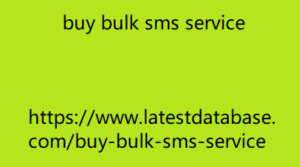Search engine optimization (SEO) doesn’t always Can You Do require help from an specialist. Anyone can study SEO best practices and use SEO tools to optimize your website in-house.
Set up analytics: Get must-have tools set up for your site, like Google Analytics 4, Google Search Console, and Google Tag Manager, to track your website’s visibility, traffic, and engagement over time.
Complete an SEO audit: Use a free tool like Screaming Frog to audit your website’s SEO and discover critical issues related to crawling, indexing, on-page optimization, and more. Set up a recurring process for auditing your site to maximize (and maintain) its rankings.
Research keywords
Bulk SMS services provide a quick and affordable buy bulk sms service solution for sending mass text messages, ideal for marketing, alerts, and customer engagement. These services offer high delivery rates and instant reach. When buying, consider factors like cost, reliability, and customer support. Bulk SMS is a powerful tool for businesses to enhance communication and boost outreach efforts.
Find and target long-tail keywords relevant to your audience that generate conversions. Free tools like SEO.com, Google Search, Google Keyword Planner, and FAQ Fox can help you master this essential step in DIY SEO.
Optimize website content: Help your website content dominate search results with on-page optimizations, like adding keywords, creating new content, writing compelling title tags, and designing shareable multimedia. SEO.com can help with this step, too!
Improve internal linking: Use the power of internal linking to improve website crawling, user journeys, and rankings. Practices like adding three to five internal links to content and using descriptive anchor text can help you maximize the impact of internal linking.
Attract backlinks: Tackle one of the most challenging parts of DIY SEO with diverse tactics, like social media sharing, email outreach, and viral content. Tools like Google Trends, Quora, and FAQ Fox can help you with this stage.
Track SEO rankings, conversions, and more: Close the gap between marketing and sales with platforms like Marketo and MarketingCloudFX, which will help you measure the real return on investment from doing SEO on your own.
Continue learning SEO: Use podcasts, blogs, and YouTube channels to grow your SEO knowledge and improve your results. If you’re doing SEO yourself, you need to commit to learning and evolving with search engine optimization.
DIY SEO tips
1. Set up analytics
Rankings. Traffic. Conversions.
You need analytics tools to measure all these SEO metrics, which is why DIY SEO starts with setting up your analytics platforms. Even if your business already has website analytics platforms like Google Analytics set up, you’ll want to double-check the setup before getting started with SEO.
For the best results, start with these platforms:
If your website already has these platforms set up, review the setups.
For example, use Google Tag Manager’s preview mode to confirm your Google Analytics: GA4 Configuration tag fires — this tag is critical because it powers your Google Analytics 4 account! You’ll also want to check Google Search Console for any errors, especially those related to indexing.
The next step in our do-it-yourself SEO checklist will also help you catch issues, so keep reading!
2. Complete an SEO audit
The second step in how to do SEO on your own is to use a free SEO tool like Screaming Frog to audit your website’s SEO and find the following:
On-page SEO issues, like missing title tags
Technical SEO issues, like canonicalized URLs
Branding issues, like outdated brand mentions
Use Screaming Frog’s installation guide to run your first site crawl. Once your crawl finishes — which can take anywhere from a few minutes to a few hours depending on your crawl settings — you can review your audit.
Screaming Frog crawl for DIY SEO
Since you’re doing SEO DIY, you’ll need to pick and choose which SEO issues get your attention.
The following questions can help you prioritize:How much time will the issue require to fix?
Who is needed to fix the issue?
XML SITEMAP
As an example, say you have the following SEO issues:
A new folder on the site is blocked from indexing
A few URLs have title tags over 60 characters
A 404 error is appearing for one of your best-selling products
Based on the earlier questions, you can prioritize the issues as follows:
A 404 error is appearing for one of your best-selling products: One of your pipelines for driving revenue is shut off. Fixing the 404 error will allow you to re-open the pipeline and resume product sales.
A new folder on the site is blocked from indexing: Since this issue affects multiple URLs, you’ll want to prioritize updating your robots.txt file. Once your update goes live, search engines can start crawling and indexing that folder’s content.
A few URLs have title tags over 60 characters: While important, this update will likely have a lower impact than the changes above. Decreasing your title tag length (in this instance) could help click-through rate (CTR).
How many issues your audit uncovers will depend on your site. The good news is you don’t have to fix all your SEO issues at once to improve your SEO. Instead, prioritize the most impactful fixes and work leftover issues into the upcoming months.
For the best results, audit your site at least once every three months.
If you want to learn more about how to do SEO DIY audits, check out these related resources:
Keywords are your gateway to reaching users via search engines.
You can get started with keyword research by using these best practices to guide your research:
Focus on long-tail keywords: At three to four words, long-tail keywords bring more qualified traffic to your site. While long-tail keywords get fewer searches, they’re less competitive, making them easier to rank than short-tail keywords.
Target relevant keywords: Just because you can rank for a keyword doesn’t mean you should target it. If you want to drive impactful results from SEO, like a new sale, focus your efforts on keywords relevant to your audience and business’s offerings.
Get keywords that convert: You’ll also want to focus on a keyword’s intent. A keyword can reveal someone’s preferred price range for a product or service, like “cheap plastic cups” or “gourmet coffee.” Use this information to target keywords that will convert for your business.
Use keywords in key places: Whenever you write content for your site, whether on your blog or on your homepage, you should use keywords naturally throughout that content. This best practice also includes any title tags or meta descriptions you create.
If you want to learn more about the basics of keyword research, check out these resources:Best Keyword Research Tools
How to Do Keyword Research
What Keywords Should I Use? (How to Find the Best Keywords)
How to Find Related Keywords
Now that you know keyword research best specific database by industry marketing practices, let’s explore how to do your own SEO keyword research.
Researching keywords isn’t as hard as it may seem! There are a lot of SEO software options, like SEO.com, out there that offer keyword suggestions for your content and information about how hard it is to rank for those keywords.
A few tools that can help you get started with keyword research include:
Sales team, which can share common questions and concerns from leads.
Customer support team, which can share common client questions and issues.
Competitor sites, which can highlight relevant topics to discuss.
Google Search, which showcases related searches to a topic.
Google Keywords Planner, which provides search volume data.
SEO.com, which generates keyword ideas from existing rankings (or competitor rankings.
FAQ Fox, which compiles online threads related to your keyword or topic.
Let’s say your business is an automotive shop. From speaking with your co-workers, you know flat tires drive new sales and lead to long-term clients. So, you investigate flat tires as a potential content topic and start with “fix flat tires.”
First, you search “fix flat tire” on Google Search. Here is what you see:
Google Search example for DIY SEO
Fueling your website for higher rankings, traffic, and aob directory revenue numbers starts with these best practices:
Prioritize users: Search engines like Google want to deliver relevant, easy-to-use content. Commit to creating a website that’s easy to use, read, and understand. For example, use headings, lists, and images to make content skimmable when writing content.
Incorporate keywords: One of the most common mistakes with DIY SEO is keyword stuffing. Focus on incorporating keywords naturally in your content — forcing a keyword will affect the user experience and appear spammy.
Use multimedia: Who gets excited about reading a wall of text? No one. So, invest the time to create multimedia for your content, whether it’s screenshots, custom graphics, or video filmed on your smartphone.
Establish a style guide: A style guide provides quick answers to common questions, like “What’s our preferred case for title tags?” or “Should all headings include the target keyword?” If you already have a style guide, work with its point of contact to add SEO guidelines.
Some common DIY search engine optimization action items for optimizing website content include:
Writing title tags between 55-60 characters
Writing meta descriptions between 140-155 characters
Organizing content into relevant headings, like H2s, H3s, and H4s
Writing SEO content that blends user needs with SEO best practices
Targeting featured snippets with an H2 heading and a concise answer
Adding descriptive alt text for images
Updating SEO content to provide new, updated information
With these best practices, you can bring structure (and success) to doing SEO on your own.


